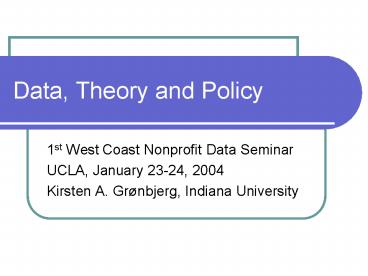Data, Theory and Policy - PowerPoint PPT Presentation
1 / 9
Title:
Data, Theory and Policy
Description:
Why we need data on nonprofits. Sector appears to be growing, ... Clubs and other mutual benefit associations. What types of geographic boundaries (and why) ... – PowerPoint PPT presentation
Number of Views:36
Avg rating:3.0/5.0
Title: Data, Theory and Policy
1
Data, Theory and Policy
- 1st West Coast Nonprofit Data Seminar
- UCLA, January 23-24, 2004
- Kirsten A. Grønbjerg, Indiana University
2
Why we need data on nonprofits
- Sector appears to be growing, changing in
composition - Increasing size, economic force doubling over
25-30 years - Growing visibility, policy relevance
- Long-term devolution from federal to
state/local levels - Long-term efforts to privatize government -
nonprofits - Increased political/policy role of religious and
other nonprofit institutions - Sector appears to be in decline, endangered
- Claims about declining civic engagement (Bowling
Alone) - Questions about state of community capacity
(inner cities) - Concerns about declining or shifting resources
- Host of other challenges
- To answer need solid data, careful methodology
3
Methodology, Content Concepts Matter
- How broadly to define the sector (and why and
how) - Field of service/industry and/or beneficiary
group - Charities (congregations, faith-based, and/or
secular) - Civic groups
- Advocacy, political organizations
- Clubs and other mutual benefit associations
- What types of geographic boundaries (and why)
- Which units headquarter, entities, programs
(and how) - What information (and how)
- Activities/practices, features, resources,
networks - Time frame and frequency
- What context and relationships to
- Individuals, households, communities
- Government market sectors
- Nonprofit infrastructure organizations
- Community social, economic, political
characteristics
4
The Indiana Nonprofit Sector Project
- Leadership build community capacity
- Enhance understanding of sectors role in state
and communities - Scope and characteristics
- Challenges, capacities, and policy impacts
- Deepen appreciation of context in which sector
operates - Benchmarks across diverse communities
- Comparisons across fields of operation
- Research fill knowledge gaps
- Utility of nonprofit databases
- Networks and Linkages opportunities, challenges
- Contributions/characteristics of all types of
nonprofits - Training develop curriculum modules
- Meet professional training needs
- Build organizational capacity
5
What Does the Project Involve?
- A comprehensive effort
- Focus on all types of nonprofits
- Statewide analysis plus community dimensions
- 7 metropolitan regions
- 5 non-metropolitan counties
- Completed or in process
- Build comprehensive database of Indiana
nonprofits - Model for other states and regions
- Survey of Indiana residents on nonprofit
affiliations - Survey of Indiana nonprofits
- Model for other states and regions
- Compile and analyze other relevant information
- Nonprofit employment, finances (Form 990)
- Planned
- Nonprofit community profiles
- In-depth case studies of nonprofit linkages
- Curriculum material and technical support
6
I. Build Comprehensive Nonprofit Database
- Institutional database approach model for other
states - Merge IRS (32,600), SOS (29,400), CL (9,000) ?
71,000 - Eliminate duplicates ? 54,100
- Low overlap of IRS/SOS 23 percent
- IRS lags SOS by 2.4 years
- Informant/community based approach
- Supplement institutional database approach
- Added 25 percent in most communities ? total of
59,400 - Now available in web-searchable format from IHC
- Analyses completed (5 papers)
- Community profiles vary by database listing
- Nonprofit density is a function of supply,
community structure - Database overlap high for some fields, larger
older NP - Database assessment validity, response rates,
distortions
7
II. Survey Residents on their NP Affiliations
- Hyper-network approach - alternative sampling
strategy - Telephone survey of 526 Indiana residents
- Focus on nonprofit affiliations
- Worship (86 percent), meeting/event attendance
(67 percent), volunteering (43 percent), work (11
percent) - Use named nonprofits as sampling frame, avoid
database - 30 percent not included in comprehensive database
- Analyses completed (3 papers)
- Types of volunteer work, associations attended
- Patterns vary by type and are related to
- Family status (few cases), SES (education),
community attachment (voter registration),
religious attendance
8
III. Survey Indiana Nonprofits
- Purpose
- Document sectors contribution to state
communities - Lay foundation for more effective collaboration
among nonprofits - Establish benchmarks for management
organizational practices - Document major nonprofit strengths challenges
- Identify differences similarities by
communities fields of activity - Random sample stratified by listings community
- 2,205 respondents 30 response rate
- Topics adapted by other states and regions
- General information programs and services
- Impact of community policy changes advocacy
activities - Relationship with other organizations
- Human resources management finances
- Special membership mutual-benefit activities
faith-based organizations - Analyses completed 3 reports/papers,
- Management capacities and challenges
(Indianapolis vs. rest of state) - Role of congregations in delivering human
services - Profile of Indiana nonprofit sector (5 others
under development)
9
IV. Analyze Nonprofit Employment
- First documentation of nonprofit employment in
Indiana - Establishments, employees, payroll, weekly wages
- By industry and by region
- For three points in time 1995, 2000, and 2001
- Adapted from methodology used elsewhere
- ES-202 reports by (almost all) employers
- Link to IRS list of tax-exempt entities under
501(c) - Underestimates nonprofit employment
- May overestimate nonprofit growth
- Analysis completed 1 report
- Employment share, growth, wage levels































